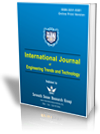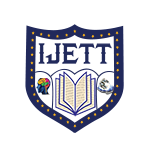Comparison of Pixel-based and Object-based Image Analysis for LULC Classification of Satellite Images
Comparison of Pixel-based and Object-based Image Analysis for LULC Classification of Satellite Imagese |
||
 |
 |
|
| © 2025 by IJETT Journal | ||
| Volume-73 Issue-2 |
||
| Year of Publication : 2025 | ||
| Author : Keerti Kulkarni, Priyadarshini K Desai, Champa PN, S. Raksha |
||
| DOI : 10.14445/22315381/IJETT-V73I2P115 | ||
How to Cite?
Keerti Kulkarni, Priyadarshini K Desai, Champa PN, S. Raksha, "Comparison of Pixel-based and Object-based Image Analysis for LULC Classification of Satellite Images," International Journal of Engineering Trends and Technology, vol. 73, no. 2, pp. 177-184, 2025. Crossref, https://doi.org/10.14445/22315381/IJETT-V73I2P115
Abstract
The analysis of the Land Use and the Land cover changes plays an important role in infrastructure management. Pixel-based classification methods are simple and intuitive and achieve good accuracy but are prone to misclassifications. This happens because the context information is not taken into consideration. In this work, an object-based image classification technique (mean shift segmentation) is implemented for the LULC classification of the Dandeli Forest area. This method groups the pixels together based on the contextual and spectral information. Further, the classification scale is also varied to arrive at an optimum segmentation scale. It is found that the accuracy initially improves when the segmentation scale is reduced (finer scale). However, after a certain point, the accuracy of the classification goes on to decrease. It is also pointed out that the scale of segmentation used here and the optimum results obtained thereof depend on the geographic area under consideration. The area under consideration has imbalanced classes, and hence, the accuracy of the algorithm depends on the scale of segmentation. The scale of segmentation depends on the parameters Spatial Radius and Range Radius. Results obtained indicate that the optimal accuracy of 91.57% is obtained when the Spatial Radius = 5 and the Range Radius = 15, below and above which the accuracy tapers off.
Keywords
Mean shift segmentation, Context-based classification, Forest mapping, Spectral angle mapping, LULC classification.
References
[1] Ashikur Rahman et al., “Performance of Different Machine Learning Algorithms on Satellite Image Classification in Rural and Urban Setup,” Remote Sensing Applications: Society and Environment, vol. 20, 2020.
[CrossRef] [Google Scholar] [Publisher Link]
[2] Akanksha Balha et al., “A Comparative Analysis of Different Pixel and Object-Based Classification Algorithms Using Multi-Source High Spatial Resolution Satellite Data for LULC Mapping,” Earth Science Informatics, vol. 14, pp. 2231-2247, 2021.
[CrossRef] [Google Scholar] [Publisher Link]
[3] Bakhtiar Feizizadeh et al., “A Comparison of the Integrated Fuzzy Object-Based Deep Learning Approach and Three Machine Learning Techniques for Land Use/Cover Change Monitoring and Environmental Impacts Assessment,” GIScience & Remote Sensing, vol. 58, no. 8, pp. 1543-1570, 2021.
[CrossRef] [Google Scholar] [Publisher Link]
[4] Manuel Carranza-Garcia, Jorge Garcia-Gutierrez, and Jose C. Riquelme, “A Framework for Evaluating Land Use and Land Cover Classification Using Convolutional Neural Networks,” Remote Sensing, vol. 11, no. 3, pp. 1-23, 2019.
[CrossRef] [Google Scholar] [Publisher Link]
[5] Monia Digra, Renu Dhir, and Nonita Sharma, “Land Use Land Cover Classification of Remote Sensing Images Based on the Deep Learning Approaches: A Statistical Analysis and Review,” Arabian Journal of Geosciences, vol. 15, 2022.
[CrossRef] [Google Scholar] [Publisher Link]
[6] Laleh Ghayour et al., “Performance Evaluation of Sentinel-2 and Landsat 8 OLI Data for Land Cover/Use Classification Using a Comparison between Machine Learning Algorithms,” Remote Sensing, vol. 13, no. 7, pp. 1-21, 2021.
[CrossRef] [Google Scholar] [Publisher Link]
[7] Christopher O. Ilori, Nima Pahlevan, and Anders Knudby, “Analyzing Performances of Different Atmospheric Correction Techniques for Landsat 8: Application for Coastal Remote Sensing,” Remote Sensing, vol. 11, no. 4, pp. 1-20, 2019.
[CrossRef] [Google Scholar] [Publisher Link]
[8] Shahab Eddin Jozdani, Brian Alan Johnson, and Dongmei Chen, “Comparing Deep Neural Networks, Ensemble Classifiers, and Support Vector Machine Algorithms for Object-Based Urban Land Use/Land Cover Classification,” Remote Sensing, vol. 11, no. 14, pp. 1-24, 2019.
[CrossRef] [Google Scholar] [Publisher Link]
[9] Diofantos G. Hadjimitsis, and Kyriacos Themistocleous, “The Importance of Considering Atmospheric Correction in the Pre-Processing of Satellite Remote Sensing Data Intended for the Management and Detection of Cultural Sites: A Case Study of the Cyprus Area,” 14th International Conference on Virtual Systems and Multimedia, pp. 9-12 , 2008.
[Google Scholar]
[10] Lakshmi N. Kantakumar, and Priti Neelamsetti, “Multi-Temporal Land Use Classification Using Hybrid Approach,” The Egyptian Journal of Remote Sensing and Space Science, vol. 18, no. 2, pp. 289-295, 2015.
[CrossRef] [Google Scholar] [Publisher Link]
[11] Jai Kumar, Brototi Biswas, and Sakshi Walker, “Multi-Temporal LULC Classification Using Hybrid Approach and Monitoring Built-up Growth with Shannon’s Entropy for a Semi-arid Region of Rajasthan, India,” Journal of the Geological Society of India, vol. 95, pp. 626-635, 2020.
[CrossRef] [Google Scholar] [Publisher Link]
[12] Narayan Panigrahi, B.K. Mohan, and G. Athithan, “Pre-Processing Algorithm for Rectification of Geometric Distortions in Satellite Images,” Defence Science Journal, vol. 61, no. 2, pp. 174-179, 2011.
[Google Scholar]
[13] Tin Ko Oo et al., “Comparing Four Machine Learning Algorithms for Land Cover Classification in Gold Mining: A Case Study of Kyaukpahto Gold Mine, Northern Myanmar,” Sustainability, vol. 14, no. 17, pp. 1-15, 2022.
[CrossRef] [Google Scholar] [Publisher Link]
[14] Y. Ouma et al., “Comparison of Machine Learning Classifiers for Multitemporal and Multisensor Mapping of Urban LULC Features,” The International Archives of the Photogrammetry, Remote Sensing and Spatial Information Sciences, vol. 43, pp. 681-689, 2022.
[CrossRef] [Google Scholar] [Publisher Link]
[15] Phan Thanh Noi, and Martin Kappas, “Comparison of Random Forest, k-Nearest Neighbor, and Support Vector Machine Classifiers for Land Cover Classification Using Sentinel-2 Imagery,” Sensors, vol. 18, no. 1, pp. 1-20, 2018.
[CrossRef] [Google Scholar] [Publisher Link]
[16] Bikash Ranjan Parida, and Shyama Prasad Mandal, “Polarimetric Decomposition Methods for LULC Mapping Using ALOS L-Band PolSAR Data in Western Parts of Mizoram, Northeast India,” SN Applied Sciences, vol. 2, pp. 1-15, 2020.
[CrossRef] [Google Scholar] [Publisher Link]
[17] Parth Sarathi Roy et al., “Anthropogenic Land Use and Land Cover Changes-A Review on Its Environmental Consequences and Climate Change,” Journal of the Indian Society of Remote Sensing, vol. 50, pp. 1615-1640, 2022.
[CrossRef] [Google Scholar] [Publisher Link]
[18] Tuisem Shimrah et al., “Spatio-Temporal Assessment on Land Use and Land Cover (LULC) and Forest Fragmentation in Shifting Agroecosystem Landscape in Ukhrul District of Manipur, Northeast India,” Environmental Monitoring and Assessment, vol. 194, 2022.
[CrossRef] [Google Scholar] [Publisher Link]
[19] A. Srivastava et al., “Mapping Vegetation and Measuring the Performance of Machine Learning Algorithm in LULC Classification in the Large Area Using Sentinel-2 and Landsat-8 Datasets of Dehradun as a Test Case,” The International Archives of the Photogrammetry, Remote Sensing and Spatial Information Sciences, vol. 43, pp. 529-535, 2022.
[CrossRef] [Google Scholar] [Publisher Link]
[20] Anuj Tiwari et al., “UAV Remote Sensing for Campus Monitoring: A Comparative Evaluation of Nearest Neighbor and Rule-Based Classification,” Journal of the Indian Society of Remote Sensing, vol. 49, pp. 527-539, 2021.
[CrossRef] [Google Scholar] [Publisher Link]
[21] Rahul Tripathi et al., “Ecosystem Services in Different Agro-Climatic Zones in Eastern India: Impact of Land Use and Land Cover Change,” Environmental Monitoring and Assessment, vol. 191, 2019.
[CrossRef] [Google Scholar] [Publisher Link]
[22] Trung V. Tran, Jason P. Julian, and Kirsten M. de Beurs, “Land Cover Heterogeneity Effects on Sub-Pixel and Per-Pixel Classifications,” ISPRS International Journal of Geo-Information, vol. 3, pp. 540-553, 2014.
[CrossRef] [Google Scholar] [Publisher Link]
[23] E. Venkateswarlu, T. Sivannarayana, and K.V. Ratna Kumar, “A Comparative Analysis of Resourcesat-2 LISS-3 and LANDSAT-8 OLI Imagery,” The International Archives of the Photogrammetry, Remote Sensing and Spatial Information Sciences, vol. 40, pp. 987-989, 2014.
[CrossRef] [Google Scholar] [Publisher Link]
[24] Pramit Verma et al., “Appraisal of Kappa-Based Metrics and Disagreement Indices of Accuracy Assessment for Parametric and Nonparametric Techniques Used in LULC Classification and Change Detection,” Modelling Earth Systems and Environment, vol. 6, pp. 1045-1059, 2020.
[CrossRef] [Google Scholar] [Publisher Link]

